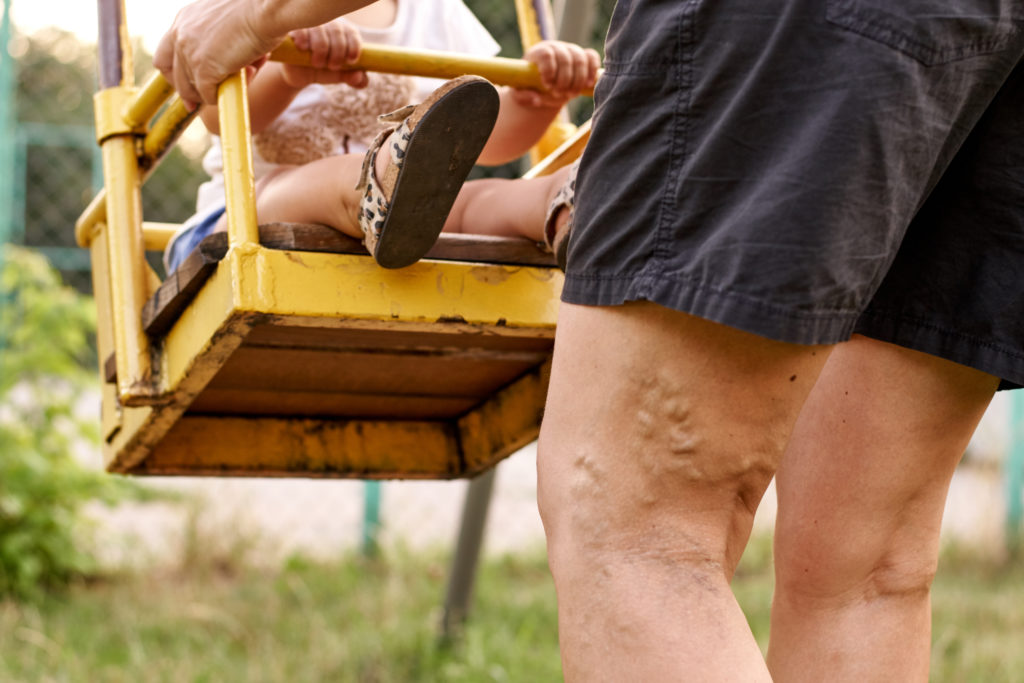Chronic Venous Insufficiency of the Lower Extremities

Chronic Venous Insufficiency of the Lower Extremities
Chronic venous insufficiency is a common medical problem that is often overlooked because of incomplete recognition of physical signs and symptoms reported by individuals and an under-appreciation of the significance of the problem by physicians. Individuals with chronic venous insufficiency can have little or no symptoms. However, more commonly, many people with this condition develop spider veins (also called telangiectasia), reticular veins (small, superficial, and visible blue or green veins), or varicose veins (veins that appear twisted and bulging). Chronic venous insufficiency may also cause swelling (edema) in the legs, brown or “rusty” discoloration of the skin, hardening and immobility of the skin and subcutaneous tissues (lipodermatosclerosis) especially in the lower leg near the inside ankle bone, pain, itching, and in severe cases, venous ulcers.
Risk Factors for Chronic Venous Insufficiency
There are multiple risk factors for developing chronic venous insufficiency, but major factors include a family history of vein problems, advancing age, a history of prolonged standing and heavy lifting, obesity, smoking, a sedentary lifestyle, lower extremity trauma, prior blood clot (venous thrombosis) in the leg, and pregnancy.
Lower Extremity Vein Function and Failure in Venous Insufficiency
To understand chronic venous insufficiency, it is helpful to know a little bit about leg veins. The lower extremities have three types of veins: deep veins, superficial veins, and perforating veins. The deep veins run through the leg muscles and have one-way valves that normally allow venous blood to flow only toward the heart. The deep veins carry approximately 85% of the blood from the legs to the heart. The flow of venous blood is increased when leg muscles contract and compress the veins during walking. Superficial leg veins are located between the muscles and the skin and drain venous blood from the skin and subcutaneous tissues. These veins also have one-way valves to help carry blood toward the heart. The perforating veins connect the smaller superficial veins to the larger deep veins and also have one-way valves that direct blood flow toward the deeper veins. When the valves in any of these veins don’t work properly, the venous blood flows in the wrong direction. Commonly, when the valves in the perforating veins fail, blood flows backward from the deep veins where the blood pressure is higher, to the superficial veins where the blood pressure is lower. As a result, the superficial veins become dilated, and the valves in them do not close properly. The volume of blood in the leg increases creating sensations of heaviness and achiness. This condition where the valves do not work properly or are insufficient, to keep the venous blood flowing in the correct direction toward the heart, is known as chronic venous insufficiency. As the condition progresses, clusters of dilated superficial veins eventually develop along the length of the leg. As the volume of blood and blood pressure in the veins continues to increase, the leg tissues swell, the veins become inflamed, and fibrosis of the subcutaneous tissues (lipodermatosclerosis) begins. Without proper treatment of these changes, leg ulcers can eventually develop.
Treatment of Chronic Venous Insufficiency
To achieve an optimal outcome with treatment and management of chronic venous insufficiency, it is imperative that individuals with the condition commit to actively participating with self-help interventions and medical recommendations.
Self-help interventions. Individuals with chronic venous insufficiency should initiate self-help practices including:
– Adopting a healthy diet and lifestyle including making efforts toward weight loss/weight management, and stopping smoking if appropriate.
– Avoiding prolonged standing or sitting.
– Elevating the feet preferably above the thighs when sitting, and above the heart when lying down, at least four times a day.
– Modifying lifestyle including increasing physical activity, or beginning a structured exercise program such as walking to strengthen calf muscles and improve vein compression.
– Applying compression to the lower extremities. Options include compression stockings, compression wraps, and compression devices. However, finding appropriate and practical compression options can be challenging. Therefore, it may be best for individuals to consult with a medical professional knowledgeable about compression regarding compression options.
Medical interventions.
There are medical procedures that can be used alone, or in combination, to treat chronic venous insufficiency. These include:
Sclerotherapy. Incompetent veins are injected with a solution that causes them to close. The blood is then directed through healthier veins. This is a common treatment option but may require multiple treatments.
Microsclerotherapy. Similar to sclerotherapy, but uses different solutions and injection techniques. It is especially effective in treating spider veins.
Endovenous thermal ablation.
A thin catheter is inserted into the incompetent vein. The catheter then applies heat to the vein causing it to collapse. A scar results and the blood is forced through nearby healthy veins. This procedure is also used to treat larger veins.
Ambulatory phlebectomy. Larger varicose veins in the legs are removed through a series of tiny skin punctures. There is usually little scarring.
When to Seek Medical Attention
If you are suffering from symptoms of chronic venous insufficiency, you should consult a doctor specializing in Vascular Medicine
if:
Your condition does not improve with self-care such as reduced time standing, the elevation of the legs, or wearing some type of compression such as compression stockings.
You have varicose veins that are painful.
And, if you have a sudden increase in leg pain or swelling, develop fever, redness of the leg, or leg sores, you should seek medical attention immediately.
 507-322-6967
507-322-6967